Marble Mountains Vietnam: A Guide to the Stunning Caves, Temples & Hidden GemsIncludes FAQs & Exclusive Video Guides for Exploring Each Mountain!
If you’re visiting Da Nang, the Marble Mountains should be at the top of your list. This breathtaking cluster of five limestone and marble hills isn’t just a scenic spot—it’s a place packed with history, spirituality, and adventure. Each mountain has its unique charm, from hidden caves and ancient pagodas to panoramic viewpoints and legendary folklore.
But here’s the thing: most visitors only explore Water Mountain (Thuy Son) and completely miss out on the other four! In this guide, I’ll take you through all five mountains, showing you exactly what makes each one special. Plus, at the end, you’ll find FAQs and video walkthroughs to help you plan the perfect trip. Let’s dive in!
Overview
Water Mountain
Metal Mountain
Fire Mountain
Wood Mountain
Earth Mountain
Which Marble Mountain to Choose?
FAQs
Watch our Water Mountain video showcasing its most stunning attractions
Overview
Located just south of Da Nang, Vietnam, the Marble Mountains are a cluster of five limestone hills, each named after the five natural elements: Metal, Wood, Water, Fire, and Earth. Over time, geological changes and sediment buildup gradually connected these once-isolated islands to the mainland, creating the unique landscape we see today.

1. Water Mountain (Thuy Son)
Water Mountain, or Thuy Son in Vietnamese, is the largest and most famous of the five Marble Mountains. This mountain is home to ancient temples and stunning caves. Some must-visit places here include: Am Phu Cave, Tang Chon Cave, Van Thong Cave, Huyen Khong Cave, Linh Ung Pagoda, Tam Thai Pagoda, and Heaven Gate.
Am Phu Cave

The entrance to Am Phu Cave—dark and mysterious.
Am Phu Cave is located near the base, next to the elevator. Its name, ‘Am Phu,’ translates to ‘hell’ in Vietnamese, and inside, you’ll find eerie carvings depicting the journey to the afterlife.
Linh Ung Pagoda
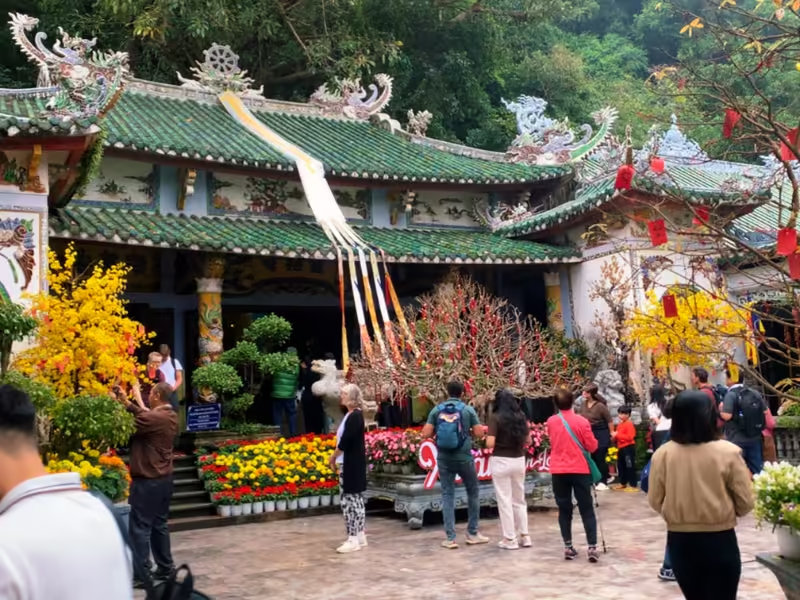
Linh Ung Pagoda – a spiritual gem in the Marble Mountains
At the foot of the mountain, you’ll climb 108 steps to reach Linh Ung Pagoda, a 200-year-old sacred site. This pagoda is a place where both locals and visitors come to pray for good fortune. In front of the temple, you’ll find a serene garden filled with colorful flowers, bonsai trees, dragon sculptures, and an impressive large Buddha statue.
Did you know that Da Nang is home to three pagodas with the same name, Linh Ung? One is on Son Tra Peninsula, another on Ba Na Hills, and the third is right here on this mountain. If you’re interested in exploring Linh Ung Pagoda on Son Tra Peninsula, check out our comprehensive guide at the link below!
Linh Ung Pagoda: The Ultimate Guide for First-Time Travelers to Da Nang
Tang Chon Cave
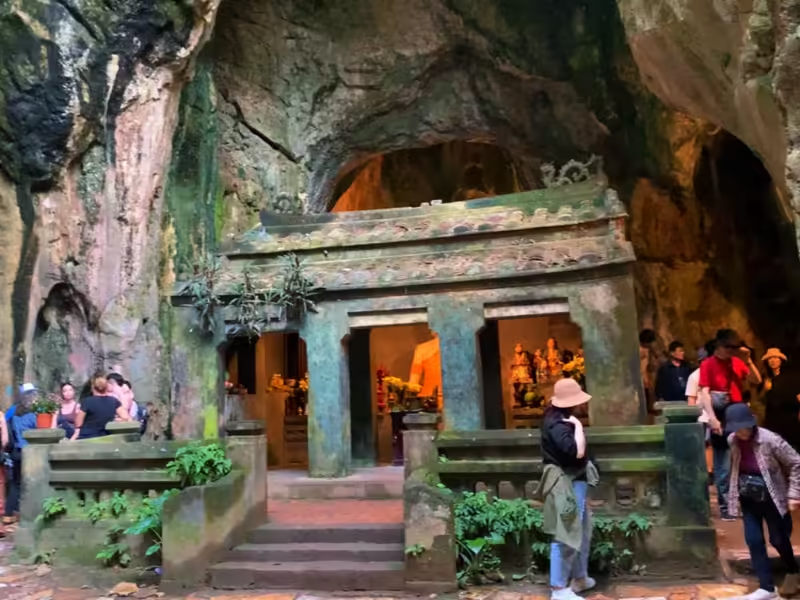
Inside Tang Chon Cave
Tang Chon Cave is located behind Linh Ung Pagoda, accessible through natural stone gateways. Inside, you’ll find smaller chambers, each housing intricately carved statues. Notably, some of these sculptures date back to the 10th century and are remnants of the ancient Cham culture
Van Thong Cave

Van Thong Cave
After exploring Tang Chon Cave, you’ll reach Van Thong Cave. This cave is quite small and has some very narrow passages—so tight that only one person can squeeze through at a time. The path inside is steep and can be a bit of a challenge, but once you make it through, you’ll step into a peaceful open space with lovely views.
Huyen Khong Cave
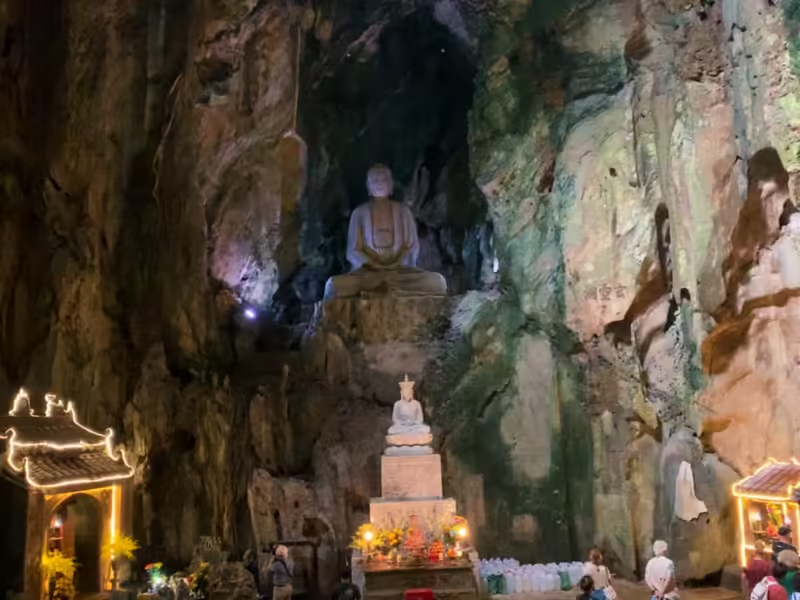
Huyen Khong Cave
Huyen Khong Cave is often considered the most beautiful cave on this mountain. As you step inside, the first thing you’ll notice is a large Buddha statue sitting right across from the entrance. Sunlight streams in through an opening at the top, casting a soft, almost mystical glow over the cave. You’ll also find several shrines where visitors come to pray. During wartime, this cave served as a hiding place for soldiers.
Tam Thai Pagoda
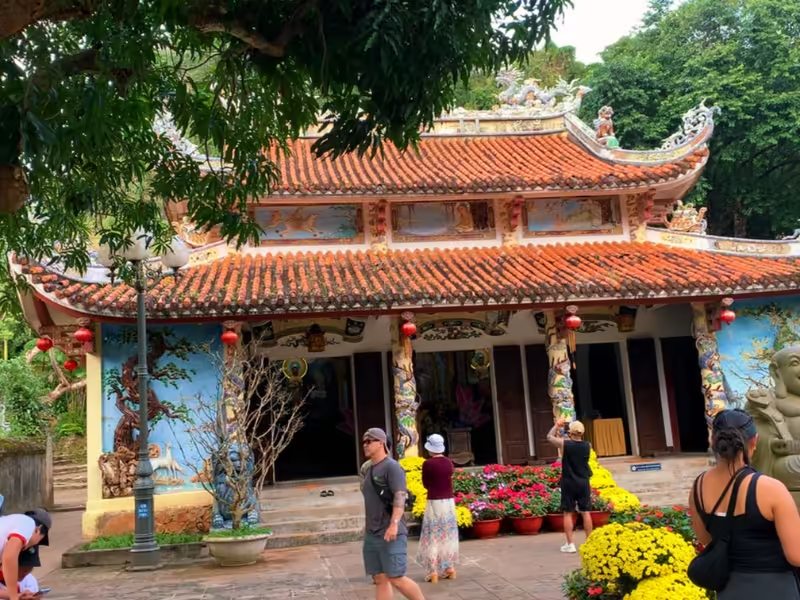
Tam Thai Pagoda
Leaving Huyen Khong Cave, make your way to Tam Thai Pagoda, a historic temple dating back to the 17th century. This small yet charming pagoda showcases traditional Vietnamese Buddhist architecture and was once honored as a national temple by the king. The peaceful atmosphere here is truly special—you can hear the soft chime of temple bells, adding to the serenity of the space.
Heaven Gate
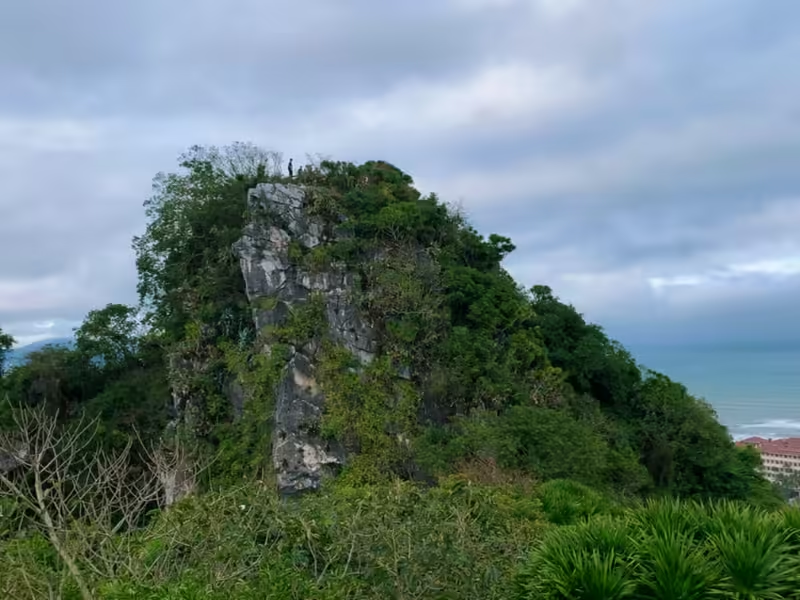
Linh Ung Pagoda – a spiritual gem in the Marble Mountains
Our final stop on this journey is Heaven Gate. To get there, you’ll follow a narrow path with stone steps, then climb over a short stretch of rugged rocks. But once you reach the top, it’s all worth it—the view stretches out to the coastline, and you can take in the fresh, cool breeze.
2. Metal Mountain (Kim Son)
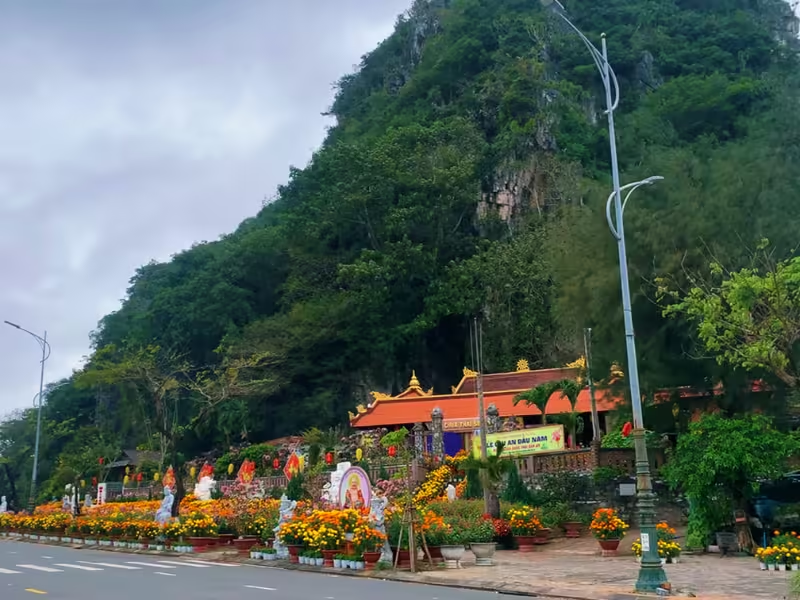
Metal Mountain and its beautiful sights.
Kim Son Mountain has a distinctive bell-shaped form and is home to the well-known Quan Am Pagoda. One of its highlights is Quan Am Cave, a 70-meter-long cavern filled with fascinating rock formations. As you make your way through, you’ll see unique stalactites and stalagmites, each with its mysterious shape. At the very end of the cave, there’s a serene, crystal-clear pool of water.
3. Fire Mountain (Hoa Son)
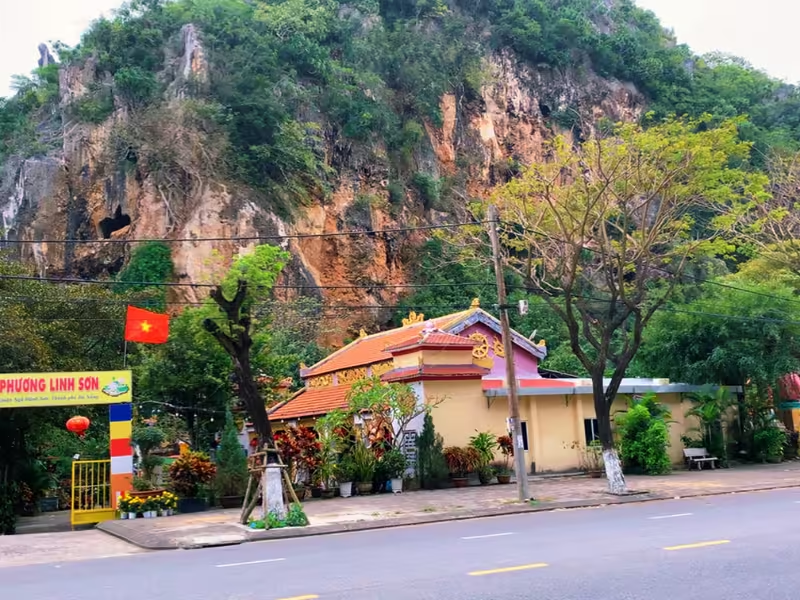
Fire Mountain and its beautiful sights.
Fire Mountain sits next to Metal Mountain, right along the banks of the Co Co River. This mountain is home to Linh Son Pagoda, a peaceful temple. One of its main highlights is Huyen Vi Cave, a spacious and beautiful cavern.
4. Wood Mountain (Moc Son)
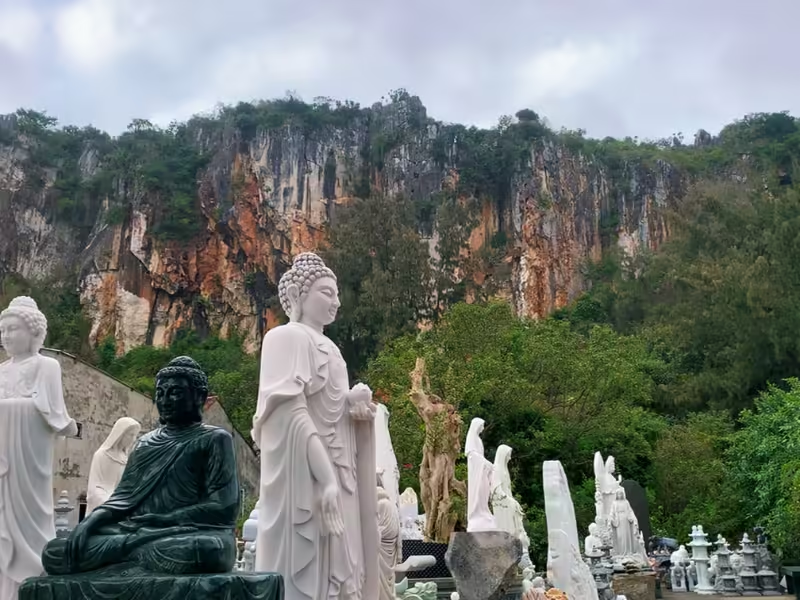
Wood Mountain
Unlike the other Marble Mountains, Wood Mountain has no temples or caves—just towering rock formations. Below, the local stone-carving village keeps ancient craftsmanship alive.
5. Earth Mountain (Tho Son)

Earth Mountain and its beautiful sights.
Earth Mountain is the lowest of the five Marble Mountains. At its base, you’ll find some small pagodas.
Which Marble Mountains are worth visiting? Here’s our honest advice
If you’re visiting the Marble Mountains, Water Mountain is the one you don’t want to miss. It’s the largest and most scenic of the five, packed with fascinating caves, temples, and beautiful viewpoints. We highly recommend starting your adventure here!
If you have extra time and want to explore further, head over to Metal and Fire Mountain. These two mountains sit next to each other and feature some hidden caves and beautiful pagodas worth checking out.
As for Wood Mountain and Earth Mountain, they don’t have as many attractions, so unless you’re really keen on seeing every mountain, you can probably skip them.
Watch our guided tour video of Metal, Fire, Wood, and Earth Mountains
Common FAQs
Marble Mountains Entrance Fee
The entrance fee for Water Mountain is 40,000 VND (about $1.6). If you take the elevator, it’s an additional 15,000 VND (around $0.6) per ride. The ticket for Am Phu Cave is 20,000 VND (about $0.8).

Marble Mountains Opening Hours
Marble Mountains is open daily from 7:00 AM to 5:00 PM
Is Marble Mountain hard to climb?
Climbing Marble Mountains can be a bit challenging in some areas. While the main paths are paved, certain spots—like the steep staircase leading to Linh Ung Pagoda or the climb to Heaven Gate—require extra effort. However, if you’re in moderate shape, you should be able to handle it. Don’t forget to wear comfortable shoes!
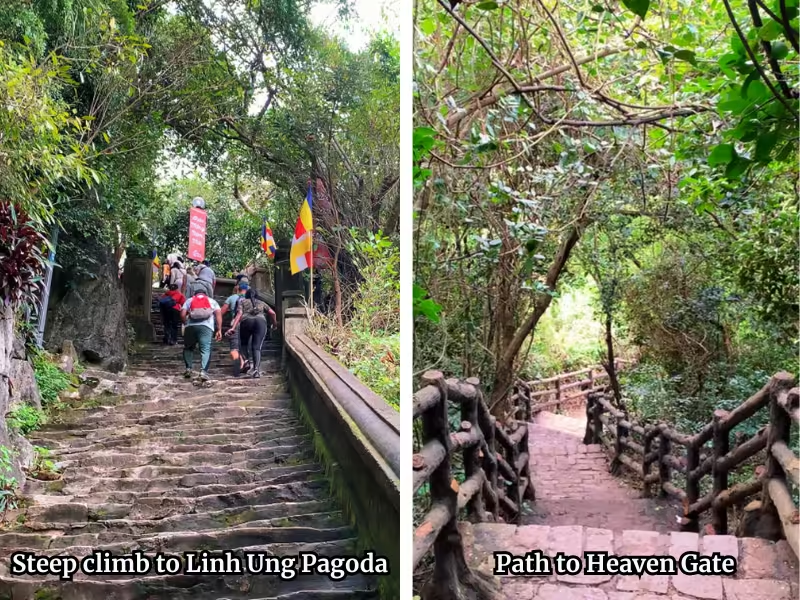
Marble Mountains Dress Code
When visiting Marble Mountains, it’s important to dress for both comfort and respect. Since exploring the site involves climbing many stairs, wear comfortable clothing and sturdy footwear. If you plan to visit the temples and pagodas, please dress modestly by covering your shoulders and knees, as these are sacred Buddhist sites
If I only have time for one, which Marble Mountain should I visit?
If you can only visit one, Thuy Son (Water Mountain) is the best choice. It is the most famous of the five Marble Mountains and features two ancient pagodas, Linh Ung Pagoda and Tam Thai Pagoda. You’ll also find stunning caves such as Am Phu Cave, Huyen Khong Cave, and Tang Chon Cave.
What are the must-see caves in Marble Mountain?
The Marble Mountains are home to several impressive caves, but these three are must-visit spots:
- Am Phu Cave (Water Mountain): A fascinating cave depicting the Buddhist concept of the afterlife, with eerie carvings and a symbolic journey through heaven and hell.
- Huyen Khong Cave (Water Mountain): A mystical cave featuring massive Buddha statues bathed in natural light, creating a serene and spiritual atmosphere.
- Quan Am Cave (Metal Mountain): A sacred site for Buddhist worshippers, dedicated to the revered Bodhisattva of Compassion, Quan Am.
How much time do you need at Marble Mountains?
For Water Mountain, plan on spending about 2-3 hours to fully enjoy its unique caves and pagodas. If you’re visiting the other four mountains—Metal, Fire, Earth, and Wood—allocate an additional 3-4 hours.
To help you plan your trip better, check out our detailed video tours:
Is Marble Mountain closer to Da Nang or Hoi An?
Marble Mountain is significantly closer to Da Nang, located only about 8 km from its center, compared to roughly 20 km from Hoi An. Additionally, it sits conveniently between the two cities—toward the south of Da Nang and the north of Hoi An.
What religion is the Marble Mountains?
The Marble Mountains in Vietnam are a spiritual site influenced by both Buddhism and Cham beliefs. Originally, the Cham people practiced Hinduism and built temples and shrines to honor their deities. Over time, however, the region evolved into a major center of Buddhism. Today, visitors can still see Cham sandstone sculptures in Huyen Khong Cave and Tang Chon Cave as reminders of its diverse spiritual heritage. By the 17th to 19th centuries, the area had become a significant Buddhist hub, now home to 14 temples—including the renowned Tam Thai Pagoda and Linh Ung Pagoda, which were designated royal temples in 1825.
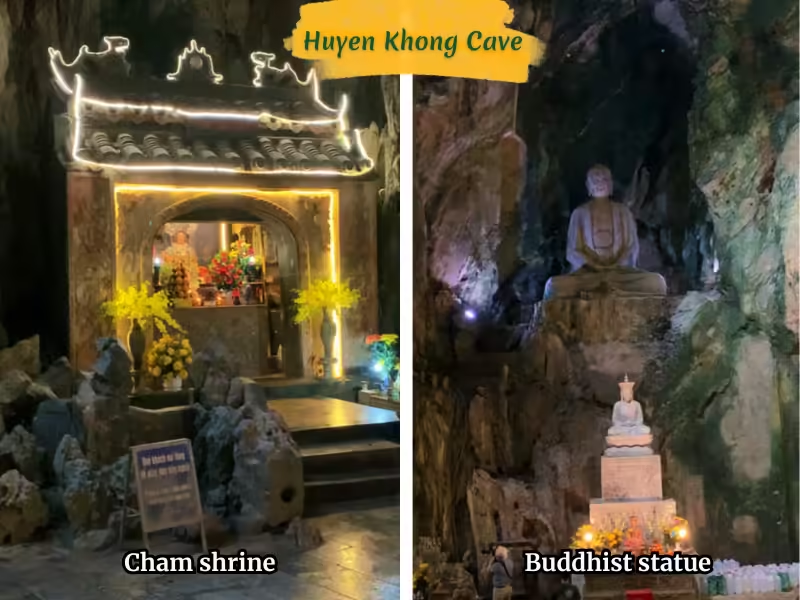
Share on FacebookShare on X (Twitter)Share on PinterestShare on WhatsappShare on LinkedinShare on TelegramShare on Email
- https://www.youtube.com/@VivaVNOfficial
- https://www.facebook.com/vivavnofficial2024
- https://www.pinterest.com/vivavnofficial/
© 2025 VivaVN. All rights reserved.


Leave a Reply